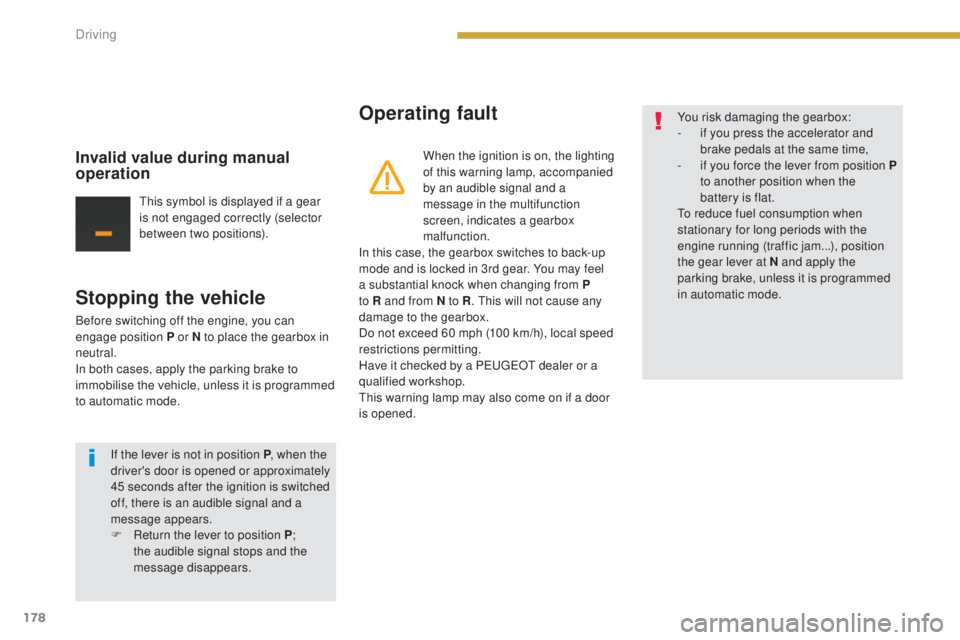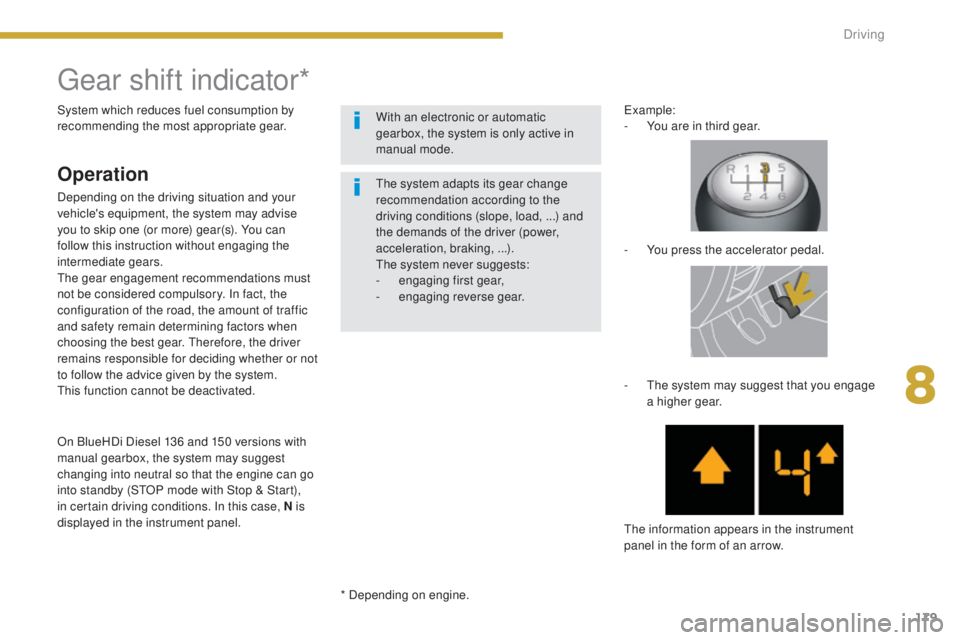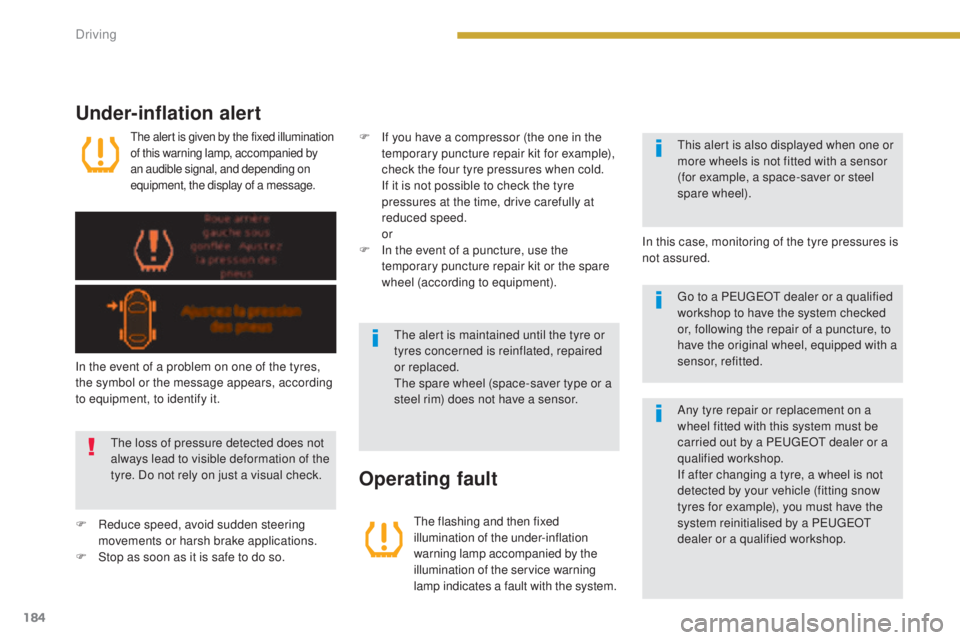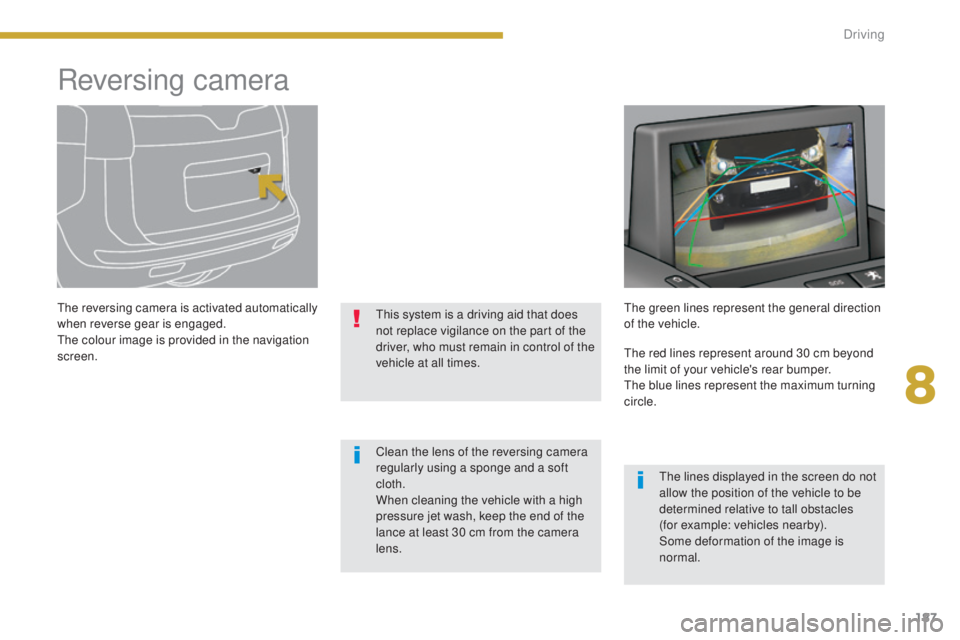2016 PEUGEOT 5008 display
[x] Cancel search: displayPage 180 of 364

178
5008_en_Chap08_conduite_ed01-2015
Stopping the vehicle
Before switching off the engine, you can
engage position P or N to place the gearbox in
neutral.
In both cases, apply the parking brake to
immobilise the vehicle, unless it is programmed
to automatic mode.
Operating fault
When the ignition is on, the lighting
of this warning lamp, accompanied
by an audible signal and a
message in the multifunction
screen, indicates a gearbox
malfunction.
In this case, the gearbox switches to back-up
mode and is locked in 3rd gear. You may feel
a substantial knock when changing from P
to R and from N to R . This will not cause any
damage to the gearbox.
Do not exceed 60 mph (100 km/h), local speed
restrictions permitting.
Have it checked by a PEUGEOT dealer or a
qualified workshop.
This warning lamp may also come on if a door
is opened.Invalid value during manual
operation
This symbol is displayed if a gear
is not engaged correctly (selector
between two positions). You risk damaging the gearbox:
-
i
f you press the accelerator and
brake pedals at the same time,
-
i
f you force the lever from position P
to another position when the
battery is flat.
To reduce fuel consumption when
stationary for long periods with the
engine running (traffic jam...), position
the gear lever at N and apply the
parking brake, unless it is programmed
in automatic mode.
If the lever is not in position P , when the
driver's door is opened or approximately
45 seconds after the ignition is switched
off, there is an audible signal and a
message appears.
F
R
eturn the lever to position P ;
the audible signal stops and the
message disappears.
Driving
Page 181 of 364

179
5008_en_Chap08_conduite_ed01-2015
Gear shift indicator*
Operation
Depending on the driving situation and your
vehicle's equipment, the system may advise
you to skip one (or more) gear(s). You can
follow this instruction without engaging the
intermediate gears.
The gear engagement recommendations must
not be considered compulsory. In fact, the
configuration of the road, the amount of traffic
and safety remain determining factors when
choosing the best gear. Therefore, the driver
remains responsible for deciding whether or not
to follow the advice given by the system.
This function cannot be deactivated.Example:
-
Y
ou are in third gear.
-
Y
ou press the accelerator pedal.
-
T
he system may suggest that you engage
a higher gear.
The information appears in the instrument
panel in the form of an arrow.
System which reduces fuel consumption by
recommending the most appropriate gear.
* Depending on engine.The system adapts its gear change
recommendation according to the
driving conditions (slope, load,
...) and
the demands of the driver (power,
acceleration, braking,
...).
The system never suggests:
-
e
ngaging first gear,
-
enga
ging reverse gear.
With an electronic or automatic
gearbox, the system is only active in
manual mode.
On BlueHDi Diesel 136 and 150 versions with
manual gearbox, the system may suggest
changing into neutral so that the engine can go
into standby (STOP mode with Stop & Start),
in certain driving conditions. In this case, N is
displayed in the instrument panel.
8
Driving
Page 186 of 364

184
5008_en_Chap08_conduite_ed01-2015
The alert is given by the fixed illumination
of this warning lamp, accompanied by
an audible signal, and depending on
equipment, the display of a message.
Under-inflation alert
The flashing and then fixed
illumination of the under-inflation
warning lamp accompanied by the
illumination of the service warning
lamp indicates a fault with the system.
Operating fault
In the event of a problem on one of the tyres,
the symbol or the message appears, according
to equipment, to identify it.
F
R
educe speed, avoid sudden steering
movements or harsh brake applications.
F
S
top as soon as it is safe to do so.The loss of pressure detected does not
always lead to visible deformation of the
tyre. Do not rely on just a visual check. The alert is maintained until the tyre or
tyres concerned is reinflated, repaired
or replaced.
The spare wheel (space-saver type or a
steel rim) does not have a sensor.This alert is also displayed when one or
more wheels is not fitted with a sensor
(for example, a space-saver or steel
spare wheel).
In this case, monitoring of the tyre pressures is
not assured. Go to a PEUGEOT dealer or a qualified
workshop to have the system checked
or, following the repair of a puncture, to
have the original wheel, equipped with a
sensor, refitted.
F
I
f you have a compressor (the one in the
temporary puncture repair kit for example),
check the four tyre pressures when cold.
I
f it is not possible to check the tyre
pressures at the time, drive carefully at
reduced speed.
or
F
I
n the event of a puncture, use the
temporary puncture repair kit or the spare
wheel (according to equipment).
Any tyre repair or replacement on a
wheel fitted with this system must be
carried out by a PEUGEOT dealer or a
qualified workshop.
If after changing a tyre, a wheel is not
detected by your vehicle (fitting snow
tyres for example), you must have the
system reinitialised by a PEUGEOT
dealer or a qualified workshop.
Driving
Page 187 of 364

185
5008_en_Chap08_conduite_ed01-2015
Visual and audible front and rear parking sensors
System consisting of four proximity sensors,
installed in the front and/or rear bumper.
It detects any obstacle (person, vehicle, tree,
barrier...) located behind the vehicle, however,
it will not be able to detect obstacles located
immediately below the bumper.The parking sensors are switched on
:
- b y engaging reverse gear,
-
a
t a speed below 6 mph (10 km/h) in
forward gear.
This is accompanied by an audible signal
and display of the vehicle in the multifunction
screen. The proximity information is indicated by:
-
a n audible signal which becomes more
rapid as the vehicle approaches the
obstacle,
-
a
n image in the multifunction screen, with
blocks which move closer to the vehicle.
The obstacle is located in relation to the
emission of the audible signal by the speakers;
front or rear and right or left.
When the distance between the vehicle
and the obstacle is less than approximately
thirty
centimetres, the audible signal
becomes continuous and/or the "Danger"
symbol appears, depending on the version of
multifunction screen.
An object, such as a stake, a roadworks
cone or any other similar object may be
detected at the start of the manoeuvre
but may no longer be detected when the
vehicle moves nearer to it.
8
Driving
Page 188 of 364

186
5008_en_Chap08_conduite_ed01-2015
The parking sensors are switched off:
- w hen you come out of reverse gear,
-
w
hen the speed is higher than 6 mph
(10
km/h) in for ward gear,
-
w
hen the vehicle has been stationary for
more than three seconds in forward gear.
Deactivation
Operating fault Reactivation
F Press button A, the warning lamp comes
on, the system is fully deactivated. If an operating fault occurs, this
warning lamp is displayed in the
instrument panel and/or a message
appears in the multifunction screen,
accompanied by an audible signal (short beep),
when reverse gear is engaged.
Contact a PEUGEOT dealer or a qualified
workshop.
In bad weather or in winter, ensure
that the sensors are not covered with
mud, ice or snow. When reverse gear is
engaged, an audible signal (long beep)
indicates that the sensors may be dirty.
When the vehicle is being driven at
a speed below approximately 6 mph
(10 km/h), certain sources of noise
(motorcycles, lorries, pneumatic
drills,
...) may trigger the parking sensor
audible signals.
The parking sensor system cannot, in
any circumstances, replace the need for
vigilance on the part of the driver.
The system will be deactivated
automatically when a trailer is being
towed or when a bicycle carrier is fitted
(vehicle fitted with a towbar or bicycle
carrier recommended by PEUGEOT).F
P
ress button A again, the warning lamp
switches off, the system is reactivated.
Driving
Page 189 of 364

187
5008_en_Chap08_conduite_ed01-2015
Reversing camera
The reversing camera is activated automatically
when reverse gear is engaged.
The colour image is provided in the navigation
screen.This system is a driving aid that does
not replace vigilance on the part of the
driver, who must remain in control of the
vehicle at all times.
Clean the lens of the reversing camera
regularly using a sponge and a soft
cloth.
When cleaning the vehicle with a high
pressure jet wash, keep the end of the
lance at least 30 cm from the camera
lens.The green lines represent the general direction
of the vehicle.
The red lines represent around 30 cm beyond
the limit of your vehicle's rear bumper.
The blue lines represent the maximum turning
circle.
The lines displayed in the screen do not
allow the position of the vehicle to be
determined relative to tall obstacles
(for example: vehicles nearby).
Some deformation of the image is
normal.
8
Driving
Page 190 of 364

188
5008_en_Chap08_conduite_ed01-2015
Parking space sensors
After measuring the parking space available
between two vehicles or obstacles, this system
gives you information on:
-
t
he possibility of fitting into a free space,
depending on the dimensions of your
vehicle and the distances needed for
manoeuvring,
-
t
he level of difficulty of the manoeuvre to
be performed.
The system does not measure spaces which
are clearly much smaller or larger than the size
of the vehicle.Displays in the instrument panel
The parking space sensor function
warning lamp can have three
different states:
-
o
ff: the function is not selected,
-
o
n fixed: the function is selected but the
conditions for measurement are not yet met
(direction indicator not operating, speed
too high) or the measurement phase has
ended,
-
f
lashing: measurement is in progress or
the message is being displayed. You can activate the "parking space sensor"
function by pressing button A
. The fixed
illumination of the warning lamp indicates that
the function is selected.
Driving
Page 191 of 364

189
5008_en_Chap08_conduite_ed01-2015
Operation
The function displays the following types of message:
Parking possibleParking difficult
Parking not advised The function deactivates itself automatically:
- w
hen you engage reverse gear,
- w hen you switch off the ignition,
-
f
ive minutes after activation of the function
or after the last measurement operation,
-
i
f the vehicle speed exceeds the threshold
of 45 mph (approximately 70 km/h) for
one
minute.
If the lateral distance between your
vehicle and the parking space is too
great, the system may not operate.
-
T
he function remains available
after each measurement and so
can measure a number of places
su c c e s s i ve l y.
-
I
n bad weather or in winter, ensure
that the sensors are not covered by
dirt, or by ice or snow.
-
T
he parking space sensor
function deactivates the front
parking sensors during the space
measuring phase when you are in
forward gear.
If there is a malfunction, have the
system checked by a PEUGEOT dealer
or a qualified workshop.
You have identified a parking space:
F
P
ress button A to activate the function.
F
A
ctivate the direction indicator on the side
where the space is to be measured.
F
D
uring the measuring, go for ward the
length of the space, at a speed less than
12
mph (approximately 20 km/h),
to prepare for your manoeuvre.
T
he system then measures the size of the
space.
F
T
he system informs you of the level of
difficulty of the manoeuvre via a message
in the multifunction screen accompanied by
an audible signal.
8
Driving